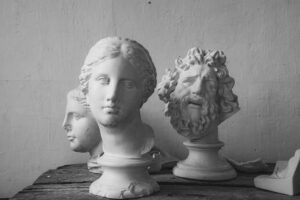Have you ever wandered through a city and felt like you were walking through an outdoor gallery? Or stood in awe of a building’s grandeur and elegance? Art and architecture are not only visually stunning, but they also play crucial roles in shaping our built environment. From the ancient pyramids to modern skyscrapers, art and architecture have left their mark on history. In this blog post, we’ll explore how these two disciplines work hand-in-hand to create the world around us, impacting our daily lives in ways both subtle and significant. So buckle up as we take a journey into the fascinating world of art and architecture!
How art and architecture shape our built environment
Art and architecture play a significant role in shaping our built environment. The design of buildings, sculptures, and public spaces can evoke emotion and inspire creativity. It creates an inviting atmosphere that encourages people to interact with their surroundings.
The use of different styles such as Gothic or Art Deco reflects the culture and the history of the community they belong to. These styles are not only visually appealing but also serve practical functions like providing shade or creating a sense of space.
Moreover, art installations enhance public spaces by adding character while promoting local artists’ work. They create a connection between us and our city’s identity by portraying its story through art.
Incorporating greenery into architectural designs helps reduce pollution levels while improving air quality for residents nearby. Streetscapes lined with trees provide shade to pedestrians during hot summer months, making them more accessible and comfortable for everyone who uses them.
It is evident that art and architecture have significant impacts on how we perceive our built environment’s aesthetic value while serving practical purposes at the same time. Therefore, incorporating these elements into urban planning should be considered essential when building future communities.
The different styles of art and architecture
Art and architecture have a long history of evolving styles that reflect the cultural, social, and political climates of their time. From ancient Greek to modern minimalist designs, here are some of the most notable styles:
Classical Architecture: This style emerged in ancient Greece and Rome, characterized by symmetrical proportions, columns, pediments, and domes.
Gothic Architecture: This style developed during medieval Europe with pointed arches, ribbed vaults, stained glass windows and intricate decorations on walls.
Baroque Architecture: Developed during 16th century Italy featuring grandeur designs with ornate decoration such as frescoes or sculptures.
Renaissance Architecture: Originated in Florence in the early 15th century which emphasized symmetry proportion amongst other traits.
Art Nouveau Style- A decorative art movement popular from about 1890 until World War I. It is characterized by sinuous lines reminiscent of plant stems or tendrils
Modernist Styles – Influenced by industrialization it features simple forms using new materials like steel & concrete combined with old ones like wood & stone
Each style has its unique characteristics that contribute to our understanding of artistic expression across different periods.
The impact of art and architecture on our daily lives
Art and architecture are an integral part of our daily lives, whether we realize it or not. The buildings we live in, the parks we visit, and the streets we walk on are all products of art and architecture. Our built environment shapes how we interact with the world around us.
The impact of art and architecture on our daily lives is profound. It can affect our mood, behavior, and overall well-being. For example, a beautiful park with sculptures can provide a peaceful retreat from busy city life while also inspiring creativity.
Similarly, the design of a building can have a significant impact on its inhabitants. Buildings that prioritize natural light and open spaces foster productivity and creativity in their occupants.
Artistic elements within public spaces such as murals or installations create community engagement by encouraging expression through different mediums. This encourages people to think critically about their surroundings which fosters civic pride.
In essence, art and architecture influence how we feel about ourselves individually as well as collectively within society; they shape who we are both physically as well as mentally due to the emotional responses they provoke in us when experienced first-hand
How art and architecture can be used to improve our built environment
Art and architecture have the power to transform our built environment in numerous ways. One of the most prominent ways is by improving the aesthetics of a space, making it more visually appealing and inviting. By incorporating art into buildings or public spaces, we can create a sense of identity and pride within a community.
Architecture also plays a significant role in improving our built environment. Designing buildings that are energy-efficient and sustainable not only benefit the environment but also save money for building owners and tenants in the long run. Architects can also design spaces that promote health and well-being by incorporating natural elements like light, air-flow, greenery or water features.
Another important aspect where art and architecture can improve our built environment is by creating inclusive public spaces that cater to diverse populations’ needs while promoting social cohesion among communities. Public art installations such as sculptures or murals can be used as an educational tool to raise awareness about historic events, cultures or social issues while providing an aesthetic value to otherwise uninviting areas.
Art-led regeneration projects are designed specifically to revitalize urban environments through creative means like street art festivals which bring new life into forgotten neighborhoods while boosting tourism revenue for local businesses.
When implemented correctly with other factors such as functionality and accessibility taken into consideration too; it’s clear how art & architecture contribute significantly towards shaping better-built environments!
Conclusion
As we have explored, art and architecture play a crucial role in shaping our built environment. From the towering skyscrapers to the modest homes we live in, every structure has been influenced by some form of artistic expression or architectural style.
The different styles that architects and artists employ are a reflection of cultural and historical influences. They tell stories about who we are as societies and how we see ourselves.
Moreover, art and architecture also have a significant impact on our daily lives. They affect our moods, emotions, productivity levels, and even physical health. Therefore it’s important to use this understanding to create spaces that are not only aesthetically pleasing but also functional.
We’ve seen how art installations can transform public spaces into interactive experiences for people of all ages while highlighting social issues that need attention. Similarly, environmentally sustainable architecture can help reduce carbon emissions while providing safe living conditions for communities around the world.
Art and architecture will always be an integral part of our built environment as they shape the world around us in ways both big and small. As cities continue to grow at unprecedented rates with new challenges emerging every day- it is imperative that designers incorporate these elements into their work so that future generations inherit healthy productive environments that inspire creativity while being environmentally friendly at the same time!








